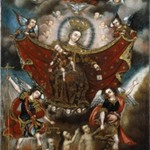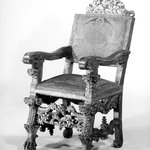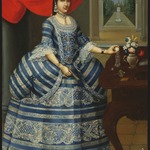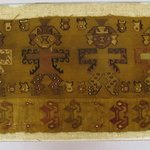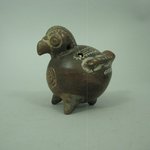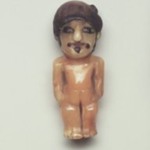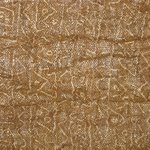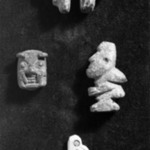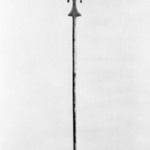
Mirror Handle
Arts of the Americas
This exquisitely carved Chimú mirror handle originally held a pyrite mirror in the concave area at the back. The object’s depiction of trophy heads (seen in the hands of the male figure) is rare for the period. The figure’s opulent attire, with a crescent headdress, serpent-headed collar, and sleeved tunic, indicates that he is a member of the ruling elite. Sacrificial victims have been found in high-status burials, and the trophy heads on this object may therefore allude to the status of the mirror’s owner.
Este mango de espejo Chimú exquisitamente tallado, originalmente sostenía un espejo de pirita en el área cóncava posterior. La representación de cabezas trofeo en este objeto (vistas en las manos de la figura masculina) es poco común en este periodo. La opulenta vestimenta de la figura, con un tocado de media luna, collar de serpiente bicéfala, y túnica con mangas, indica que era un miembro de la clase gobernante. Victimas sacrificadas se han encontrado en entierros de alta posición social, por lo que las cabezas trofeo en este objeto podrían aludir al rango del dueño del espejo.
Este mango de espejo Chimú exquisitamente tallado, originalmente sostenía un espejo de pirita en el área cóncava posterior. La representación de cabezas trofeo en este objeto (vistas en las manos de la figura masculina) es poco común en este periodo. La opulenta vestimenta de la figura, con un tocado de media luna, collar de serpiente bicéfala, y túnica con mangas, indica que era un miembro de la clase gobernante. Victimas sacrificadas se han encontrado en entierros de alta posición social, por lo que las cabezas trofeo en este objeto podrían aludir al rango del dueño del espejo.
CULTURE
Chimú
MEDIUM
Wood, gold, turquoise, red pigment
DATES
ca. 850–1470
PERIOD
Late Intermediate Period
DIMENSIONS
11 5/8 x 5 9/16 in. (29.5 x 14.1 cm) (show scale)



COLLECTIONS
Arts of the Americas
ACCESSION NUMBER
86.224.4
CREDIT LINE
Gift of the Ernest Erickson Foundation, Inc.
CATALOGUE DESCRIPTION
Wooden mirror handle with carvings that portray a well-dressed individual, standing on a small pedestal, holding a trophy head in each hand. The individual wears a tunic with sleeves, a crescent-shaped headdress, and a collar with a serpent head. On the figure's tunic, headdress, legs, and elsewhere are triangles in relief. On the handle, collar, and headdress are turquoise bead inlays. Around the inlays are traces of red pigment. The eyes of the central figure as well as the eyes of the trophy heads are inlaid with thin sheets of gold that are covered over with red pigment. In the back of the carving is a shallow circular cavity which probably held a pyrite mirror.
Condition: The front of the proper left side of the handle is damaged; the headdress of the central figure is chipped, broken, and repaired; the tunic has two gouges; the hair of each trophy head is chipped along the edges; the end of the handle is cracked. The object reveals overall surface wear.
EXHIBITIONS
MUSEUM LOCATION
This item is not on view
CAPTION
Chimú. Mirror Handle, ca. 850–1470. Wood, gold, turquoise, red pigment, 11 5/8 x 5 9/16 in. (29.5 x 14.1 cm). Brooklyn Museum, Gift of the Ernest Erickson Foundation, Inc., 86.224.4. Creative Commons-BY (Photo: Brooklyn Museum, 86.224.4_PS2.jpg)
IMAGE
overall, 86.224.4_PS2.jpg. Brooklyn Museum photograph, 2007
"CUR" at the beginning of an image file name means that the image was created by a curatorial staff member. These study images may be digital point-and-shoot photographs, when we don\'t yet have high-quality studio photography, or they may be scans of older negatives, slides, or photographic prints, providing historical documentation of the object.
RIGHTS STATEMENT
Creative Commons-BY
You may download and use Brooklyn Museum images of this three-dimensional work in accordance with a Creative Commons license. Fair use, as understood under the United States Copyright Act, may also apply.
Please include caption information from this page and credit the Brooklyn Museum. If you need a high resolution file, please fill out our online application form (charges apply).
For further information about copyright, we recommend resources at the United States Library of Congress, Cornell University, Copyright and Cultural Institutions: Guidelines for U.S. Libraries, Archives, and Museums, and Copyright Watch.
For more information about the Museum's rights project, including how rights types are assigned, please see our blog posts on copyright.
If you have any information regarding this work and rights to it, please contact copyright@brooklynmuseum.org.
RECORD COMPLETENESS
Not every record you will find here is complete. More information is available for some works than for others, and some entries have been updated more recently. Records are frequently reviewed and revised, and we welcome any additional information you might have.


